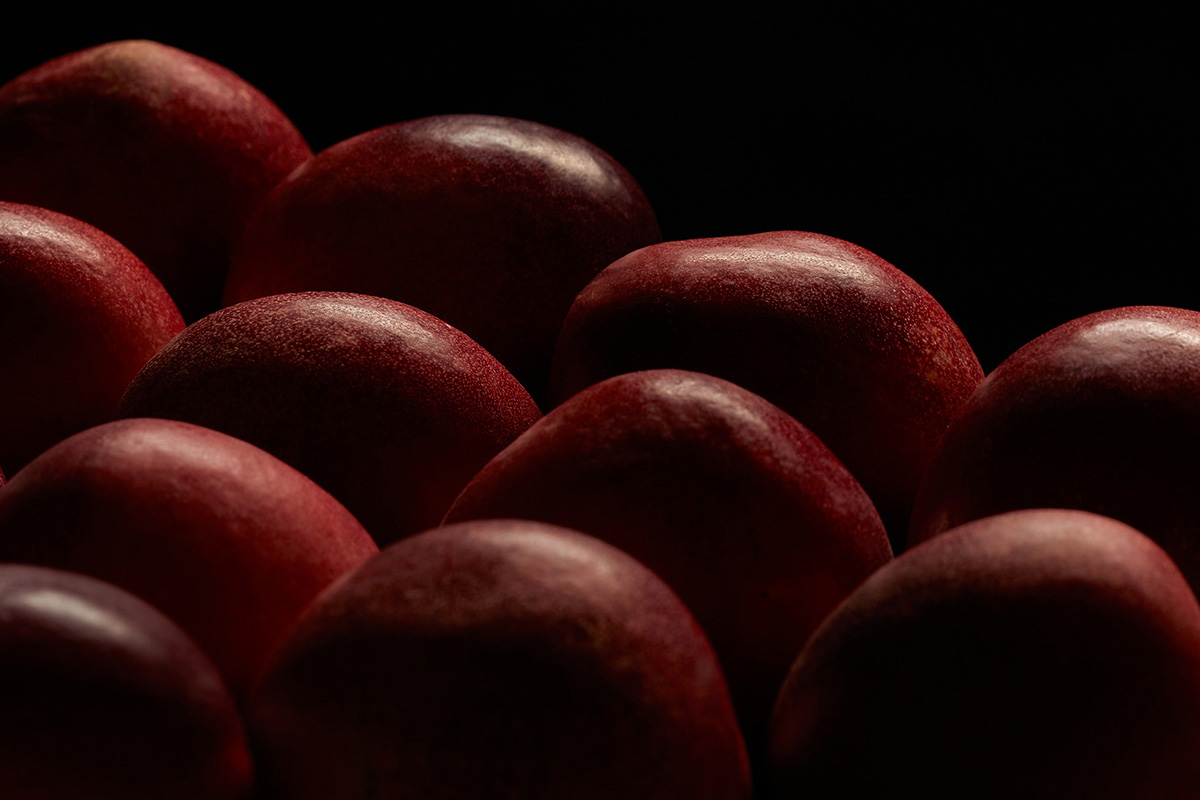Food for Thought
Adam Borman uses his Tamron 70-200mm F2.8 VC G2 telephoto lens to create moody abstracts of fruits and veggies.
Share the article:
More Photo Tips | Video Gallery | Photo Gallery | Enewsletter sign-up
By Jenn Gidman
Images by Adam Borman
It was at the Northern Alberta Institute of Technology in Edmonton where Adam Borman first fell in love with commercial food photography and advertising photography—he knew the direction his career would take even before he graduated. “I feel fortunate that I stumbled upon such a satisfying path so early on,” he says.
Adam has been immersed in the genre ever since, but recently, he craved trying something a bit different: abstract food photography. “It’s such a universal subject, but at the same time, there are varying options on what you can photograph and how,” he says. “I wanted to create something a little darker, moodier, and more subdued than my usual commercial work.”
To create this photo series, Adam used his Tamron SP 70-200mm F/2.8 Di VC USD G2 telephoto lens. “I enjoy shooting with this lens so much,” he says. “For my commercial work, I tend to stay in the 70mm-85mm range. But I took all of these photos at 200mm, so I could achieve a bit more compression. I’ve found that with many zoom lenses, the sharpness falls off or the image quality is otherwise poor when you get to those longer focal lengths. Not the Tamron 70-200mm—it offered me clear, sharp photos throughout.”
Read on as Adam dives deeper into his photo shoot.
How did you select what food to photograph?
I picked my subjects based on their colors and textures, as well as my desire to create a gradient effect from light to dark if you placed the images side by side. I wanted them to appear more like a series rather than a random selection of one-offs. Ideally, in a carousel gallery, I’d start off with the red apples and peaches, then move on to the oranges and bananas, then to the watermelon and green bell peppers, and finally to the eggplant. It was a strategic way to shoot so I could give each photo its own unique appeal while maintaining a sense of cohesion.

70-200mm (200mm), F14, 1/125 sec., ISO 160
Click image to view larger

70-200mm (200mm), F14, 1/125 sec., ISO 160
Click image to view larger
Talk about lighting for commercial food photography.
I thought it was important to only use one light; I wanted a very concentrated source. I used a 1-foot-by-6-foot stripbox, a long, narrow modifier that can light most of my subjects. I knew that some of the fruit and vegetables, especially the eggplant, were going to be glossy and pick up specular highlights from the light. By using the stripbox, I was able to achieve beautiful, long streaks of gloss, as opposed to if I’d used something wider and created squares of light instead. That wouldn’t have added much highlight to what would otherwise have been a very shadowy image.

70-200mm (200mm), F14, 1/125 sec., ISO 160
Click image to view larger
How did you decide on how to arrange your subjects?
I always try to have an idea beforehand on what I'm shooting and how. I knew I wanted the items here to not be blatantly recognizable, with a focus on the curves and shapes of the fruits and vegetables. The eggplant photo is probably my favorite—it’s got so many natural waves and inconsistencies, making the image look almost like a painting of a landscape, with hills and valleys.

70-200mm (200mm), F14, 1/125 sec., ISO 160
Click image to view larger
Through my arrangements, I hoped the images would be slightly ambiguous, but at the same time highlight the organic nature and differences in texture in each of the various items, all while creating depth in each photo. For instance, with the oranges, their dimples stand out, and I tried to position them so the light would accentuate that. If there was a single fruit or vegetable that I focused on more in a particular image, I would make sure that the other fruits or vegetables complemented that main subject. That sometimes took a bit of arranging and rearranging until I got everything the way I wanted it.

70-200mm (200mm), F16, 1/125 sec., ISO 200
Click image to view larger
What are some challenges in taking photos like this?
The most important thing is to pay special attention to your light source for commercial food photography. If you only have a camera and lens at your disposal, use a window. If you have black fabric on hand, you can cover up the window to varying degrees to see what different types of highlight shapes you can create in the fruits and veggies, and the different quality of light you can get. You want the light to seamlessly interact with your subjects, and to enhance the mood you’re trying to evoke.

70-200mm (200mm), F13, 1/125 sec., ISO 125
Click image to view larger
So much of this kind of shoot is an exercise in composition and design. Take your time in planning out exactly what you want to do, arrange it carefully in front of your camera, make sure your lighting is right, and start shooting!

70-200mm (200mm), F16, 1/125 sec., ISO 200
Click image to view larger
To see more of Adam Borman’s work for food photography, check out his website and Instagram.
Is your Tamron News subscription up to date? Click to subscribe to all editions of Tamron News featuring how-to tips, new product news, contest announcements and inspiration!
More Photo Tips | Watch Videos | Learn More About Tamron Lenses | Photo Gallery
